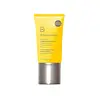What's inside
What's inside
 Key Ingredients
Key Ingredients

 Benefits
Benefits

 Concerns
Concerns

 Ingredients Side-by-side
Ingredients Side-by-side

Water
Skin ConditioningDibutyl Adipate
EmollientButylene Glycol
HumectantGlycerin
HumectantDiethylamino Hydroxybenzoyl Hexyl Benzoate
UV FilterIsononyl Isononanoate
EmollientTitanium Dioxide
Cosmetic ColorantPEG-12 Dimethicone
Skin ConditioningEthylhexyl Triazone
UV AbsorberHydrogenated Polydecene
EmollientMethylene Bis-Benzotriazolyl Tetramethylbutylphenol
UV FilterCaprylyl Methicone
Skin ConditioningSilica
Abrasive1,2-Hexanediol
Skin ConditioningHydroxyacetophenone
AntioxidantDiethylhexyl Carbonate
EmollientArginine
MaskingDecyl Glucoside
CleansingHydroxyethyl Acrylate/Sodium Acryloyldimethyl Taurate Copolymer
Emulsion StabilisingAcrylates/C10-30 Alkyl Acrylate Crosspolymer
Emulsion StabilisingIsoceteth-20
EmulsifyingCI 77492
Cosmetic ColorantIsohexadecane
EmollientTocopheryl Acetate
AntioxidantCaprylic/Capric Triglyceride
MaskingTriethoxycaprylylsilane
Cordyceps Sinensis Extract
AntioxidantTrametes Versicolor Extract
Alumina
AbrasiveCI 77491
Cosmetic ColorantPolysorbate 60
EmulsifyingPropylene Glycol
HumectantMagnesium Ascorbyl Phosphate
AntioxidantSodium Hyaluronate
HumectantXanthan Gum
EmulsifyingMarrubium Vulgare Extract
Skin ConditioningLaminaria Ochroleuca Extract
Skin ConditioningBuddleja Davidii Extract
Skin ConditioningSodium Benzoate
MaskingPotassium Sorbate
PreservativeCitric Acid
BufferingTheobroma Cacao Seed Extract
AntioxidantWater, Dibutyl Adipate, Butylene Glycol, Glycerin, Diethylamino Hydroxybenzoyl Hexyl Benzoate, Isononyl Isononanoate, Titanium Dioxide, PEG-12 Dimethicone, Ethylhexyl Triazone, Hydrogenated Polydecene, Methylene Bis-Benzotriazolyl Tetramethylbutylphenol, Caprylyl Methicone, Silica, 1,2-Hexanediol, Hydroxyacetophenone, Diethylhexyl Carbonate, Arginine, Decyl Glucoside, Hydroxyethyl Acrylate/Sodium Acryloyldimethyl Taurate Copolymer, Acrylates/C10-30 Alkyl Acrylate Crosspolymer, Isoceteth-20, CI 77492, Isohexadecane, Tocopheryl Acetate, Caprylic/Capric Triglyceride, Triethoxycaprylylsilane, Cordyceps Sinensis Extract, Trametes Versicolor Extract, Alumina, CI 77491, Polysorbate 60, Propylene Glycol, Magnesium Ascorbyl Phosphate, Sodium Hyaluronate, Xanthan Gum, Marrubium Vulgare Extract, Laminaria Ochroleuca Extract, Buddleja Davidii Extract, Sodium Benzoate, Potassium Sorbate, Citric Acid, Theobroma Cacao Seed Extract
Water
Skin ConditioningZinc Oxide
Cosmetic ColorantCaprylic/Capric Triglyceride
MaskingDimethicone
EmollientDicaprylyl Carbonate
EmollientCoco-Caprylate/Caprate
EmollientButyloctyl Salicylate
Skin ConditioningPropanediol
SolventLauryl Polyglyceryl-3 Polydimethylsiloxyethyl Dimethicone
Skin ConditioningPolyhydroxystearic Acid
EmulsifyingPolymethylsilsesquioxane
Tranexamic Acid
AstringentAloe Barbadensis Leaf Juice
Skin ConditioningHibiscus Sabdariffa Flower Extract
Skin ConditioningPongamia Pinnata Seed Extract
Skin ConditioningSaccharide Isomerate
HumectantSodium Hyaluronate
HumectantEthylhexylglycerin
Skin ConditioningDimethicone/Polyglycerin-3 Crosspolymer
CleansingMagnesium Hydroxide
AbsorbentTriethoxycaprylylsilane
Magnesium Sulfate
Disteardimonium Hectorite
StabilisingSodium Chloride
MaskingTriethyl Citrate
MaskingSodium Citrate
BufferingTetrasodium Glutamate Diacetate
Phenoxyethanol
PreservativePotassium Sorbate
PreservativeWater, Zinc Oxide, Caprylic/Capric Triglyceride, Dimethicone, Dicaprylyl Carbonate, Coco-Caprylate/Caprate, Butyloctyl Salicylate, Propanediol, Lauryl Polyglyceryl-3 Polydimethylsiloxyethyl Dimethicone, Polyhydroxystearic Acid, Polymethylsilsesquioxane, Tranexamic Acid, Aloe Barbadensis Leaf Juice, Hibiscus Sabdariffa Flower Extract, Pongamia Pinnata Seed Extract, Saccharide Isomerate, Sodium Hyaluronate, Ethylhexylglycerin, Dimethicone/Polyglycerin-3 Crosspolymer, Magnesium Hydroxide, Triethoxycaprylylsilane, Magnesium Sulfate, Disteardimonium Hectorite, Sodium Chloride, Triethyl Citrate, Sodium Citrate, Tetrasodium Glutamate Diacetate, Phenoxyethanol, Potassium Sorbate
Ingredients Explained
These ingredients are found in both products.
Ingredients higher up in an ingredient list are typically present in a larger amount.
This ingredient is an emollient, solvent, and texture enhancer. It is considered a skin-softener by helping the skin prevent moisture loss.
It helps thicken a product's formula and makes it easier to spread by dissolving clumping compounds.
Caprylic Triglyceride is made by combining glycerin with coconut oil, forming a clear liquid.
While there is an assumption Caprylic Triglyceride can clog pores due to it being derived from coconut oil, there is no research supporting this.
Learn more about Caprylic/Capric TriglyceridePotassium Sorbate is a preservative used to prevent yeast and mold in products. It is commonly found in both cosmetic and food products.
This ingredient comes from potassium salt derived from sorbic acid. Sorbic acid is a natural antibiotic and effective against fungus.
Both potassium sorbate and sorbic acid can be found in baked goods, cheeses, dried meats, dried fruit, ice cream, pickles, wine, yogurt, and more.
You'll often find this ingredient used with other preservatives.
Learn more about Potassium SorbateSodium Hyaluronate is hyaluronic acid's salt form. It is commonly derived from the sodium salt of hyaluronic acid.
Like hyaluronic acid, it is great at holding water and acts as a humectant. This makes it a great skin hydrating ingredient.
Sodium Hyaluronate is naturally occurring in our bodies and is mostly found in eye fluid and joints.
These are some other common types of Hyaluronic Acid:
Learn more about Sodium HyaluronateTriethoxycaprylylsilane is a silicone used to bind and stabilize ingredients.
As an emulsifier, it helps prevent ingredients from separating. This can help elongate the shelf life of products.
Triethoxycaprylylsilane is often used to coat mineral sunscreens ingredients to help give a better feel. It also helps reduce oxidative stress in sunscreens.
Learn more about TriethoxycaprylylsilaneWater. It's the most common cosmetic ingredient of all. You'll usually see it at the top of ingredient lists, meaning that it makes up the largest part of the product.
So why is it so popular? Water most often acts as a solvent - this means that it helps dissolve other ingredients into the formulation.
You'll also recognize water as that liquid we all need to stay alive. If you see this, drink a glass of water. Stay hydrated!
Learn more about Water